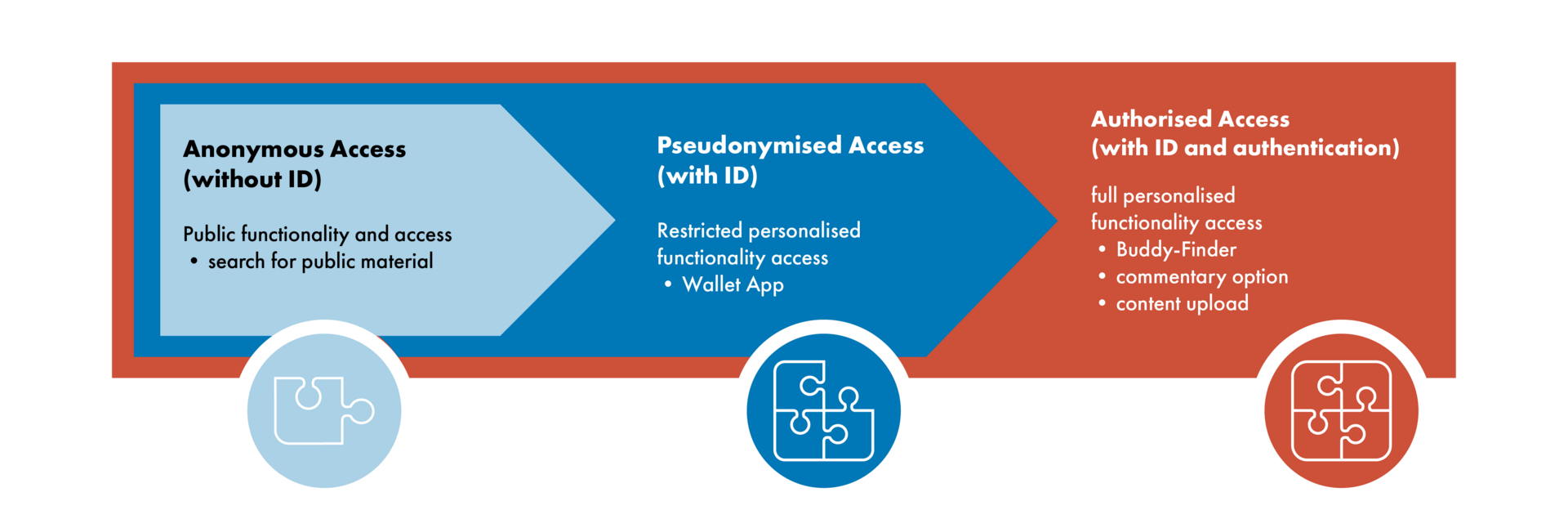Foundation
- Single sign-on
- Identity provider with identity management
- Authentication and authorisation infrastructure
Developing a networking infrastructure for educational connections

“Mein Bildungsraum” as a digital networking infrastructure is built on five technical components: Digital Identities, Storage, Digital Credentials, Data Space, and Showcase. The initiative is funded through the German Recovery and Resilience Plan (DARP).
Between October 2023 and June 2024, users were able to test the first minimally functional version of the networking infrastructure (MVP) and provide feedback.
Following the test phase, the Federal Ministry of Education and Research (BMBF) transferred the baseline version of the networking infrastructure to the Federal Agency for Disruptive Innovation (SPRIND) on July 1, 2024. SPRIND’s objective is now to position “Mein Bildungsraum” for the future and transition it into regular operation.
To achieve this, SPRIND has prioritized the first three components — Digital Identities, Storage, and Credentials — as they are key to simplifying processes in education and reducing administrative barriers.
In school, at university or with a commercial provider, every learning step requires individual access today. This means that users have to keep creating new profiles and provide their personal data to various education providers. Personal identity verification is also required again for each provider. This quickly becomes unmanageable and users have little control over the personal information stored in the respective profiles.
Identity providers (IdP) for various educational services already create and administer digital identities. So many students might already have a digital identity stored an education authority, a university or some learning platform.Through an authentication and authorisation infrastructure (AAI), the network infrastructure provides a single sign-on service so that logging on to the national learning platform also provides access to connected platforms and educational services. Existing initiatives are being considered here. The digital identities component provides access to a variety of educational services with one login. It forms the basis for uniform identity and access management.
For users who currently do not have a digital identity, the network infrastructure provides a base-identity through an identity provider. Users can create, administer and erase this base-identity themselves through a build-in identity management (IDM).

Each student’s personal data is currently stored by each education provider. As therefore personal data is spread across numerous learning providers, managing can become hard or cumbersome. For sharing data between educational services, reports or certificates have to be downloaded and uploaded repeatedly. Furthermore, it can be challenging to keep track of where required documents or data is stored. Deleting personal information for example, is rarely possible by simply clicking a button.
With the “Mein Bildungsraum” wallet app, users can manage all their personal data, reports or certificates (e.g. a school-leaving certificate or a confirmation of attendance). They can also request deletion of personal data from within the app. Data protection and data security are top priorities. A transmission protocol shows what information was shared with whom.
Technologically, the current solution is based on Enmeshed as its programming framework, whose source code is open and publicly accessible (an open-source framework). It is continuously being developed and is intended to be fully compatible with the EUDI Wallet in the long term.

Various education providers issue digital certificates. Utilization of digital certificates requires trusting both the issuing institution and signed document itself. In particular for smaller educational providers, it is often challenging to meet sealing and signature requirements. Documentation has to be transferred in full for processing and cannot be signed within the own sphere of control.
The network infrastructure encompasses a domain-specific public key infrastructure (PKI), establishing a basis of trust for Digital certificates. Formal and non-formal learning providers are administered jointly. Central registration authorities ensure that certificates can only be issued by uniquely identified and authorised institutions. The actual content of the digital certificates never leaves the respective educational institution’s sphere of control.

Using an educational provider’s digital learning or collaboration tool, usually requires being a member of the respective institution. A shared workspace across organisations is currently lacking. This impedes information exchange of students and teachers across educational providers.
The digital network infrastructure’s Showroom permits the creation of a tailor-made work environment. Institutions do this independently by providing access to the tools of their learning environment. Central functions of external learning providers can be easily added to the specific gallery using drag & drop. The opportunity for networking between all learners on the platform is another option offered by the Showroom. With the Buddy Finder, users will have the option of easily finding people who are interested in similar topics or with whom they have things in common.
Machine-readable data suitable for further processing is a key requirement for comprehensive search functionality and matching mechanisms to identify suitable educational services. To date, non-personal information about courses, continuing education and curricula is provided digitally in various formats, levels of details and quality. This makes the information difficult to correlate and use comprehensively in the learning space.
Establishing the data space for the digital network infrastructure correlates and links the metadata of different providers. This makes it possible, for example, to find educational services. Editing tools are provided to facilitate the administration of learning opportunity metadata by providers.
PhD candidate Maria, wants to learn more in the field of data analysis. She uses the network infrastructure’s learning scout to search for various commercial and non-commercial offers in the education space. By sharing her preferences and qualifications with the learning scout, the search results are automatically limited for her in the background. Based on the metadata stored in the data room, the learning scout only displays offers relevant for her context to Maria, helping her quickly find what she needs